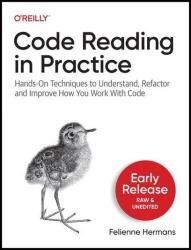Code Reading in Practice: Hands-On Techniques to Understand, Refactor and Improve How You Work With Code (Early Release)
- Добавил: literator
- Дата: 29-09-2022, 02:28
- Комментариев: 0
 Название: Code Reading in Practice: Hands-On Techniques to Understand, Refactor and Improve How You Work With Code (Early Release)
Название: Code Reading in Practice: Hands-On Techniques to Understand, Refactor and Improve How You Work With Code (Early Release)Автор: Felienne Hermans
Издательство: O’Reilly Media, Inc.
Год: 2022-09-29
Язык: английский
Формат: epub, mobi
Размер: 10.2 MB
Reading code is an essential skill, but many organizations today don't teach, practice, or even discuss it. Developers who lack the ability to read code well can't perform good code reviews, assess code quality, or decide on the use of an open source library. In two parts, this practical book helps developers become more comfortable at reading code.
In the first part, you'll learn hands-on techniques for code reading, such as structural analysis, content analysis, and conceptual analysis. In part two, author Felienne Hermans from the Vrije Universiteit Amsterdam, shows you how to apply those techniques to code snippets from well-known code bases, allowing you to practice the skills you learned in part one.
The exercises and techniques in this chapter help to answer questions like: Is the code organized in methods and classes? What methods and classes depend on each other? What is the ‘flow’ of the code? Are there clear entry points such as a main method where the code execution will start? At the end of the chapter, you will know X techniques to be applied to more deeply understand code structure of a new code base.
In object-oriented languages, functional components take the form of methods within classes. Singular components are not possible in most pure OO languages like Java or C#, components that are not objects must live within classes and as such there are no singular variables outside classes. Inside classes they take the form of fields. In functional languages variables may always be declared, inside or outside functions. Nowadays, many languages allow for multiple paradigms including functional and object-oriented, for example Python or jаvascript. In these languages all three components can (and will often) be present.
With this book, you will:
Learn methods and techniques for reading unfamiliar code
Use code reading techniques for structure, content, concepts, and context
Make decisions around code quality quickly and with more confidence
Read code more efficiently while debugging
Make decisions for adopting libraries, frameworks, or architectural patterns
Use code reading techniques to on-board and to make architectural decisions
Use the IDE effectively to read code
Скачать Code Reading in Practice (Early Release)
Внимание
Уважаемый посетитель, Вы зашли на сайт как незарегистрированный пользователь.
Мы рекомендуем Вам зарегистрироваться либо войти на сайт под своим именем.
Уважаемый посетитель, Вы зашли на сайт как незарегистрированный пользователь.
Мы рекомендуем Вам зарегистрироваться либо войти на сайт под своим именем.
Информация
Посетители, находящиеся в группе Гости, не могут оставлять комментарии к данной публикации.
Посетители, находящиеся в группе Гости, не могут оставлять комментарии к данной публикации.
